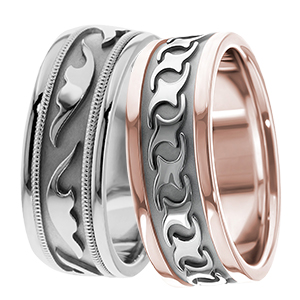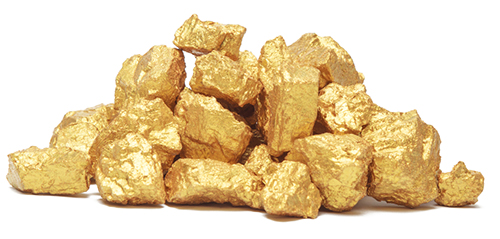- 800-275-1257 ×
-
ALL DEPARTMENTS
 WEDDING BANDS
WEDDING BANDS ENGAGEMENT RINGS
ENGAGEMENT RINGS DIAMOND RINGS
DIAMOND RINGSJEWELRY & GIFTS
- MY ACCOUNT Hello. Sign In
- CONTACT US
- Price Match Guarantee

Gold is a rare metallic element that is found in natural settings, mostly in veins of quartz and in certain other alluvial deposits. It can be found in a free state or in combination with other metals.
Gold, as a precious metal, has been valued and held in high esteem since ancient times and is still one of the most highly prized metals that has, throughout the ages, been used to symbolize wealth and power. Some speculate that gold is probably the earliest known metal because it has been found in tombs and among artifacts dating back to the earliest known civilizations.
Easily shaped, carved, melted, chiseled or hammered, gold is one of the softest, densest, metals that exist.
Because it is so soft, it is alloyed with other minerals like silver and platinum to make it stronger and more durable.
It is the metal most often used by jewelers and other artisans because of its flexibility and it's durability and it is not easily affected by moisture, normal heat, air, or everyday wear and tear. Because gold is a very good conductor of electricity and heat, it is widely used for industrial purposes and manufacturing applications.
Gold was once used extensively as dentures and dental fillings because of it's soft demeaner and it's easiness to shape. Although it is still used in some dental applications, it is not used for dentistry purposes as extensively today.
Other usages gold include biological and medical research, photographic imaging, and because it is has a high resistance to corrosion, it is used in sensitive instruments and other mechanical devices.
Gold is a rare and precious metal that is used in a wide variety of applications, but most notably, it is used to make jewelry and coins. As fine jewelry, gold is used more than any other metals because of it's durability, lasting shine, and it's consummate, eye catching, beauty. Gold's soft nature gives jewelers or craftsmen the ability to carve, melt, and or mold it into intricate designs and shapes, and objects. It's high luster and brilliance makes it a perfect mate for diamonds, pearls, emeralds, rubies, aquamarine, ivory, garnet, opal, and most other precious gemstones. Whether gemstones are mounted to it, or whether gold is used independently for rings, necklaces, bracelets, pendants, or other precious pieces of jewelry, gold makes a most fascinating object of delicate sophistication. The brilliance of gold jewelry attracts, men, women, and children alike, who wear and cherish it with passion. Gold has always stood out from other precious metals because of it's historic symbolism and it's overall value.
Gold jewelry dates back to man's earliest known existence and it has never lost it's appeal. The ancient Egyptians, Africans, Romans, Native American Indians, Persians, Chinese, Europeans, and most other long societies relished gold and gold jewelry.
Even today, the amount of gold jewelry that is owned by an individual, or a family, still represents social status and wealth.
Gold's purity is measured in karats. The term "karat" harks back to the ancient bazaars where "carob" beans were used to weigh precious metals. 24 karat is pure gold, but its purity means it is more expensive and less durable than gold that is alloyed with other metals. Different alloys are used in jewelry for greater strength, durability and color range. The karatage of the jewelry will tell you what percentage of gold it contains: 24 karat is 100 percent, 18 karat is 75 percent, and 14 karat is 58 percent gold. When comparing gold jewelry, the higher the number of karats, the greater the value.

Gold Carat Gold Colors Gold comes in a rainbow of colors, each one of them providing an opportunity to please a customer who wants something different from what’s sold on every street corner and every home shopping program.
But customers who want this interesting jewelry also want to know details about it. Natural yellow gold takes on a new hue when alloyed with a sufficient amount of another metal.
Colored gold alloys are just as "real" as their golden colored counterparts. Pure gold is generally too soft to be used for jewelry, so other metals are nearly always added to it, no matter which color of gold is being prepped for jewelry making.